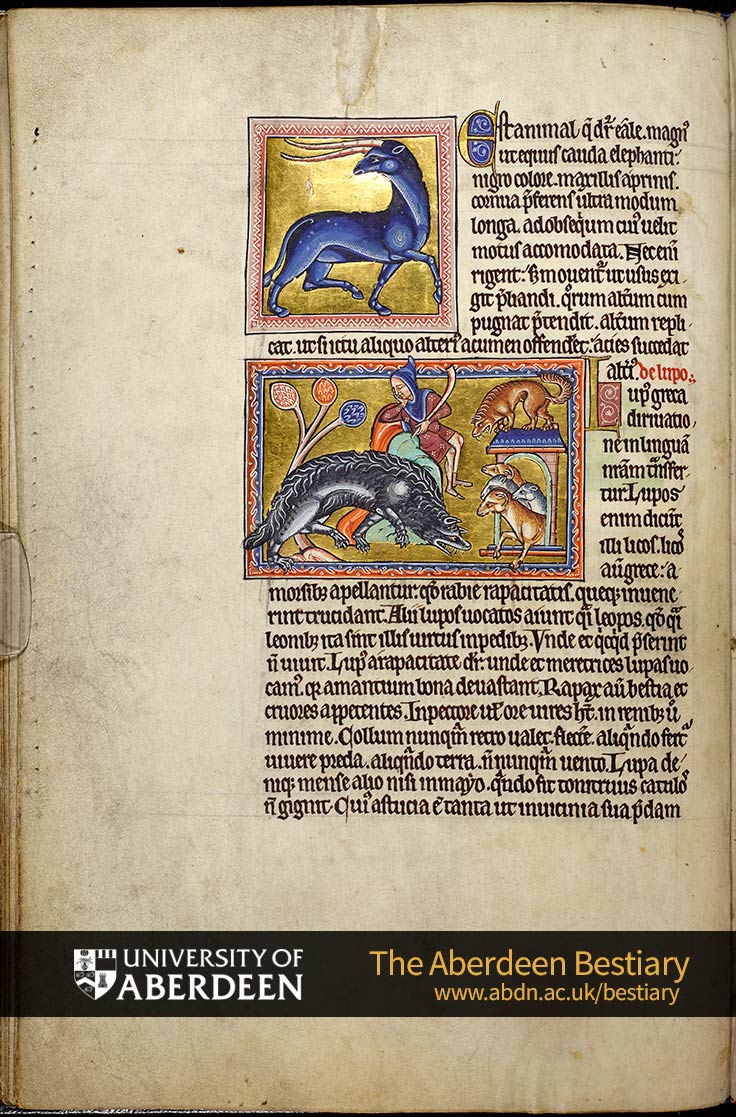Folio 16v - De eale; the yale. De lupo; the wolf.
There is an animal called the yale. It is black, as big as a horse, with the tail of an elephant, the jaws of a boar and unusually long horns, adjustable to any movement the animal might make. For they are not fixed but move as the needs of fighting require; the yale advances one of them as it fights, folding the other back, so that if the tip of the first is damaged by a blow, it is replaced by the point of the second.
Of the wolf The word lupus, wolf, in our Latin tongue derives from the Greek. For the Greeks call it licos; this comes from the Greek word for 'bites', because maddened by greed, wolves kill whatever they find. Others say the word lupus is, as it were, leo-pos, because like the lion, leo, their strength is in their paws, pes. As a result, whatever they seize does not survive. Wolves get their name from their rapacity: for this reason we call whores lupae, she-wolves, because they strip their lovers of their wealth. The wolf is rapacious beast and craves blood. It strength lies in its chest or its jaws, least of all in its loins. It cannot turn its neck around. It is said to live sometimes on its prey, sometimes on earth and sometimes, even, on the wind. The she-wolf bears cubs only in the month of May, when it thunders. Such is the wolf's cunning that it does not catch food for its cubs near its lair
- Commentary
-
Commentary
Text
The yale. The wolf.
Illustration
The yale is as large as a horse, is black, and has an elephant's tail and the jaws of a wild boar. Its horns are long and mobile: one can fold backwards while the other fights. The wolf approaches a sheepfold like a dog, stealthily and silently, without waking the shepherd. His eyes shine at night like lamps.
Comment
Pricking and ruling are visible. Initial indicator 'e' in left margin. Initial type 2.
Folio Attributes
- Transcription and Translation
-
Transcription
Est animal quod dicitur eale. Magnus\ ut equus cauda elephanti,\ nigro colore, maxillis aprinis,\ cornua preferens ultra modum\ longa, ad obsequium cuius velit \ motus accomodata. Nec enim\ rigent, sed moventur ut usus ex\igit preliandi, quorum alterum cum\ pugnat pretendit, alterum repli\cat, ut si ictu aliquo alterius acumen offenderet, acies succedat alterius. \De lupe\ Lupus greca\ dirivatio\ne in linguam nostram transfer\tur. Lupos\ enim dicunt\ illi licos, licos\ autem grece, a \ morsibus apellantur, quod rabie rapacitatis, queque invene\rint trucidant. Alii lupos vocatos aiunt quasi leopos, quod quas\i leonibus ita sint illis virtus in pedibus. Unde et quicquid preserint\ non vivit. Lupus a rapacitate dicitur, unde et meretrices lupas vo\camus, quia amantium bona devastant. Rapax autem bestia et\ cruores appetentes. In pectore vel ore vires habet, in renibus vero\ minime. Collum nunquam retro valet flectere. Aliquando fertur\ vivere preda, aliquando terra, nonnunquam vento. Lupa de\nique mense alio nisi in Mayo, quando fit tonitruus catulos\ non gignit. Cuius astucia est tanta ut in vicinia sua predam\Translation
There is an animal called the yale. It is black, as big as a horse, with the tail of an elephant, the jaws of a boar and unusually long horns, adjustable to any movement the animal might make. For they are not fixed but move as the needs of fighting require; the yale advances one of them as it fights, folding the other back, so that if the tip of the first is damaged by a blow, it is replaced by the point of the second. Of the wolf The word lupus, wolf, in our Latin tongue derives from the Greek. For the Greeks call it licos; this comes from the Greek word for 'bites', because maddened by greed, wolves kill whatever they find. Others say the word lupus is, as it were, leo-pos, because like the lion, leo, their strength is in their paws, pes. As a result, whatever they seize does not survive. Wolves get their name from their rapacity: for this reason we call whores lupae, she-wolves, because they strip their lovers of their wealth. The wolf is rapacious beast and craves blood. It strength lies in its chest or its jaws, least of all in its loins. It cannot turn its neck around. It is said to live sometimes on its prey, sometimes on earth and sometimes, even, on the wind. The she-wolf bears cubs only in the month of May, when it thunders. Such is the wolf's cunning that it does not catch food for its cubs near its lair

